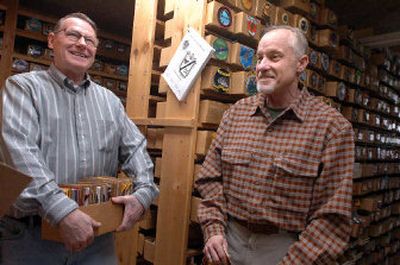Patches of honor

HAYDEN, Idaho – Larry Rupp started collecting military patches at the age most boys start collecting baseball cards.
In 1942, a soldier in Ohio’s 10th Infantry Division Mountain Unit pulled a patch off the sleeve of his Army uniform and gave it to Rupp, who was 10 at the time. Pearl Harbor was still fresh in people’s minds, and Rupp treasured the colorful bit of cloth.
“I still have it,” he said, “and I’ve collected patches ever since.”
Rupp’s collection has grown to 4,000 military patches – no two alike. These days, however, the retired prison warden from Lucasville, Ohio, orders the patches from a North Idaho company, instead of begging them from soldiers.
From a garage-like warehouse in Hayden, McGrogan’s Patch Designs sells patches commemorating Army, Navy, Air Force, Marine and Coast Guard units. Last year, vets and collectors bought 46,000 of them over the company’s Web site, through eBay, and at conventions and gun shows. Most retail for $4 to $7.
Hollywood has also discovered the company. Actors in “Saving Private Ryan” and “Clear and Present Danger” wore McGrogan’s patches on their uniforms.
The 4-by-4-inch squares evoke memories of World War II battlefields, sunken submarines and the fall of Saigon. Sometimes, they move men to tears.
“We’ve had people cry on the phone,” said company founder Don McGrogan. “Their dad’s died, and he was in Vietnam or the Second World War. They want a memento from his time in the service.”
Each embroidered patch contains the name of the unit and a logo. Ships, camels, dragons and mythical sea creatures appear on the patches. Some designs are copies of period patches. Others are McGrogan originals.
McGrogan, a retired career Navy man, designs each patch. Before he begins sketching, he researches each unit’s missions, casualty list and honors, consulting a personal library of more than 10,000 volumes. In each small square, he tries to distill the pride and camaraderie that goes along with military service.
McGrogan’s attention to detail makes his patches favorites with collectors.
“They’re really better than the ones the guys got in World War II,” said Rupp, a long-time customer.
Rupp spent four years in the Navy during the Korean War. Like McGrogan, he’s a military buff who researches units’ histories. “We try and keep a little of the honor of the units alive,” he said.
McGrogan and his stepson, Randy Sweet, run McGrogan’s Patch Designs out a 4,000-square-foot former welding shop. Thousands of boxes of inventory line shelves with military precision.
The firm also has a sales representative in Portland. A Chicago supplier manufactures the patches.
The business began as a hobby in 1982, when McGrogan started collecting patches himself. By the time he had amassed more than 1,000 patches, he had begun thinking about business opportunities. Each year, McGrogan designs 150 to 200 new patches. Most have military connections, though his work also includes patches for Schweitzer Mountain’s ski patrol and Trail of the Coeur d’Alenes cyclists.
McGrogan, 62, speaks with a “Philadelphia Irish” brogue — a legacy of his childhood in the Irish-Catholic neighborhood of Fishtown. As a kid in a poor family, McGrogan dreamed of travel and higher education. The Navy gave him both. He joined after high school, and stayed for 26 years.
“I started with the Cuban missile crisis, and was in every conflict up until 1987,” he said.
Sweet, his partner in the business, is a Vietnam vet, former nurse and chemical dependency counselor.
Both men enjoy talking to other veterans and their families. The partners also keep an eye out for their patches on Fox News and other stations.
“If you watch the History Channel and you see the old World War II veterans wearing pocket patches, a lot of them are ours,” Sweet said. “We get to talk to some pretty famous people, see them on TV and read about the books they wrote.”